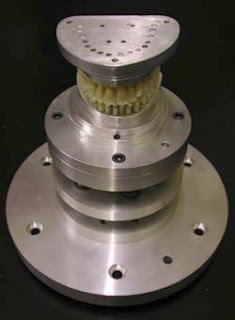Dental robot chews over a toothy problem

A robotic system that mimics the biting, chewing and munching of the human jaw is being developed by UK researchers. Called Dento-Munch, it should provide a more realistic way to test materials for use in dentistry, they say.
Some £2.5 billion is spent every year in the UK alone on dental materials, which are used to replace or strengthen teeth. But Kazem Alemzadeh, an engineer at Bristol University and the Bristol Robotics Laboratory, says the way these materials respond to everyday wear and tear can be hard to predict.
"Without this knowledge the likely long-term performance of the materials cannot be judged," Alemzadeh told New Scientist.
Lengthy clinical trials can show how these materials will fare, but are expensive and time-consuming to perform. Machines that act as surrogate mouths for "chew-testing" are cheaper and faster but, until now, they have been poor imitators of humans, says Alemzadeh.
Realistic movement
With colleagues, he is working on the first robot that can reproduce the full movement of the human jaw. Two platforms act as the upper and lower jaws, with the lower jaw capable of moving in 6 degrees of freedom. Just like the human jaw, it can move and rotate around each 3D axis: up and down, forwards and backwards, and left and right.
"Current laboratory simulators utilise only 2 degrees of freedom," says Alemzadeh, "and results from different simulators are often very different."
The software controlling the motors and gearboxes inside Dento-Munch are also designed to respond to loads in a similar way to muscle and tendon.
Furthermore, feedback loops in the control system slow the chewing when resistance is high, and speed it up when there is less resistance, to give a more realistic response. Data collected from people chewing will be used to calibrate the system.
Limited uses
John McCabe researches dental materials at Newcastle University, UK. He says that replicating the mechanical processes of chewing could improve testing, but that Dento-Munch may not be useful in all cases. For example, testing materials for suitability of use within a living mouth is best done using biological lab experiments.
He adds that "a perfect simulation will take months or years for each test, as in the mouth", and working out how to perform accelerated tests will be difficult.
However, Alemzadeh believes the system could even have non-dental spin-offs, for example helping use robots to rehabilitate injured ankles. "Chewing and ankle movement are similar motions," he says.
Comments